RUSSIA (MOSCOW, ST. PETERSBURG AND MORE) – Travel guide for opera, classical music and culture
Russia: A guide for music fans Visit destinations to classical music and opera art with a historical reference. Learn exciting ideas and background information.
1
GOOGLE MAPS - OVERVIEW OF DESTINATIONS
Here you can find the locations of all described destinations on Google Maps.
1
2
LIFE AND WORK OF ARTISTS IN RUSSIA
Russia has a long tradition of famous composers as Tchaikovsky, the mighty five or the important composers of the 20th century
2
3
CONCERT HALLS AND OPERA HOUSES
St. Petersburg and Moscow are home to magnificent and historic opera houses and concert halls. One even played an important role in the Second World War.
3
4
MUSEUMS
Russia cherishes the heritage of its composers and you will find tips for seven museums in the guide.
4
5
HOUSES AND APARTMENTS OF ARTISTS
Where Tchaikovsky met his mysterious death.
5
6
MONUMENTS
Three Statues in St. Petersburg and Moscow
6
7
RESTAURANTS
Where Tchaikovsky may have contracted cholera
7
8
CEMETERIES AND TOMBS OF FAMOUS MUSICIANS
Visit the graves of famous artists in the two monumental cemeteries in Moscow and St. Petersburg.
8
GOOGLE MAPS – OVERVIEW OF DESTINATIONS
Zoom in for destinations in RUSSIA:
LIVE AND WORK OF ARTISTS IN RUSSIA
Mikhail Glinka
The overfather of Russian music
Mikhail Glinka can be considered the forefather of Russian classical music. He spent most of his active life in St. Petersburg. The opera “A Life for the Tsar” of 1834 is considered the first independent Russian classical music and, consequently, the first Russian opera and had a decisive influence on the next generations of Russian musicians. It was the first opera whose story played in Russian and in which a man from the people played the leading role and not a nobleman, which was unheard of for that time.
Model for the mighty five
Rimsky-Korsakoff and the “mighty five”, in particular, embraced his legacy and established national Russian music (as opposed to the more Western-oriented Tchaikovsky). The work, as well as Glinka’s second important opera “Ruslan and Ludmila,” premiered at St. Petersburg’s Bolshoi Theater (not to be confused with Moscow’s), which was demolished in 1888 to make way for the new Conservatory.
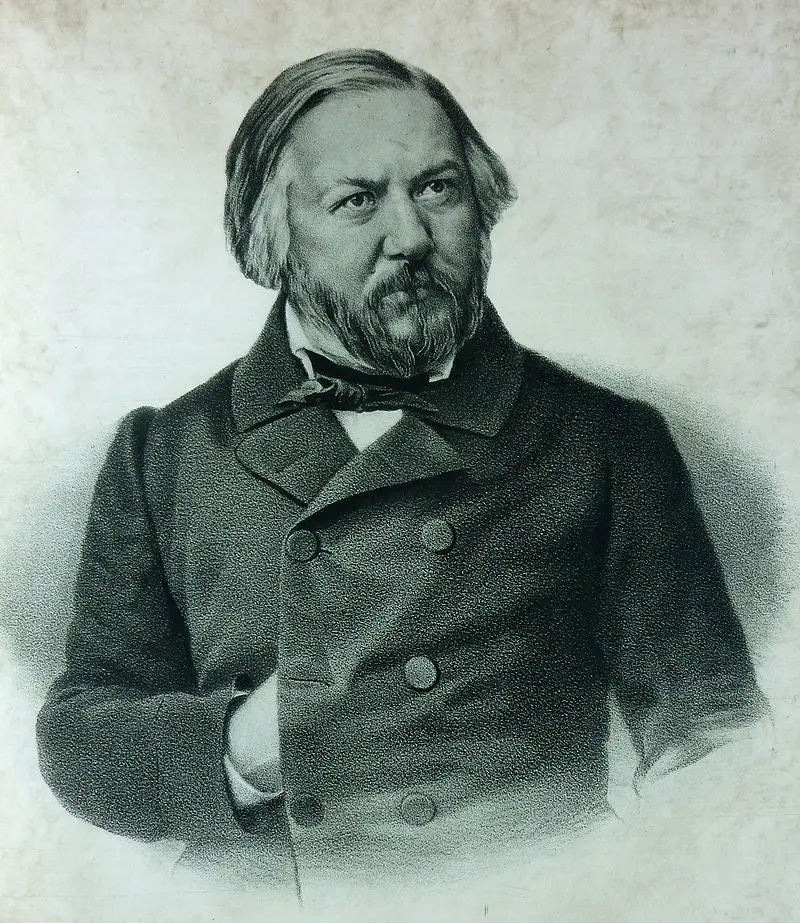
Nikolai Rimsky-Korsakoff.
Member of the mighty five
Rimsky-Korsakoff held an immensely important position in 19th-century Russian musical life. He absorbed the ideas of Glinka, the first Russian composer, drew inspiration from Balakirev, Berlioz, and Liszt, and was a member of he St. Petersburg powerful group that championed national Russian music.
He especially supported and encouraged fellow composer Mussorgsky, whose “Boris Godunov” he twice reworked, for example. Among his students were such resounding names as Stravinsky, Glasunov, and Prokovieff. His best-known works are probably “Scheherazade,” a program music influenced by Liszt, and “the Flight of the Bumblebee” from one of his operas.
Korsakoff came from a wealthy family with an army tradition; he himself went to sea for three years in his officer training until he decided to pursue music.
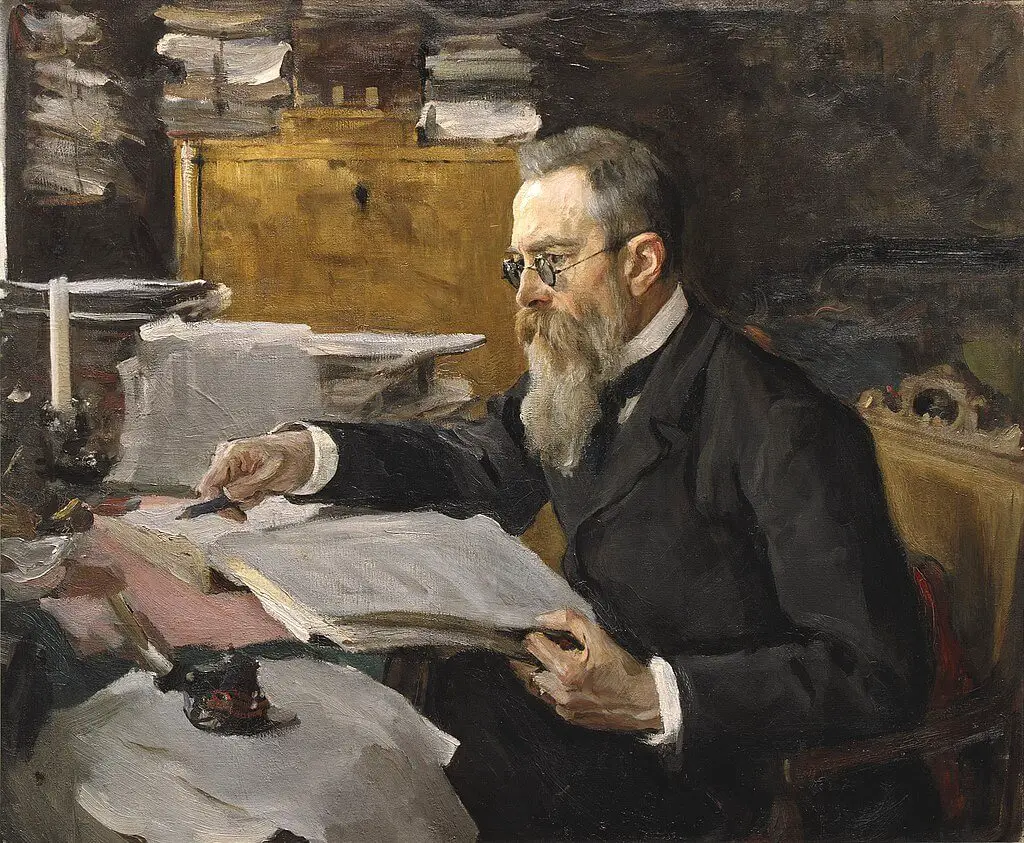
Modest Mussorgsky
Mussorgsky in St. Petersburg
Mussorgsky spent most of his artistically productive years in St. Petersburg. He was born in 1839 400 km south of St. Petersburg. He arrived there at the age of 13 to begin his education at a cadet school, according to family tradition, with a later career as a civil servant.
However, he left this path at the age of 19 to devote himself to music, but kept working in civil service positions to make a living. Mussorgsky lived on and off in residential cooperatives, at times in the commune of the “Mighty Handful” (with Balakirev, Borodin, Cui, Rimsky-Korsakov). His alcohol consumption and lack of formal musical training prevented a larger oeuvre, but his compositions of “Pictures at an Exhibition”, “Boris Godunov” and “Night on the Bald Mountain” achieved world renown (listen below to a excursus on his opera “Boris Godunov”).
Mussorgsky in Moscow
Mussorgsky’s artistic center throughout his life was in St. Petersburg, but it was his first visit to Moscow at the age of 20 that made a deep impression on him and triggered a “love for everything Russian.”
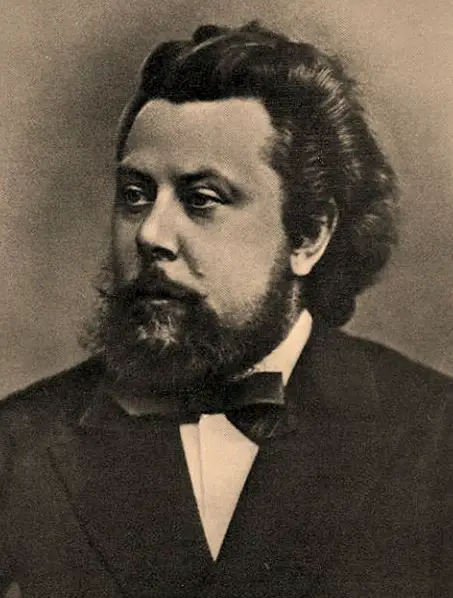
Sergey Prokoffiev
Return to Moscow
An exiled Russian, Prokofiev had emigrated in the wake of the October Revolution and returned to Moscow in 1936 to remain permanently in the Soviet Union. This move still amazes many today, as he voluntarily submitted to the artistic constraints of Stalin’s Bolshevik dictatorship. The period that followed was artistically very productive and the hoped-for surge in creativity that the composer wished for when he returned home became a reality.
The Ukrainian-born composer did not return to St. Petersburg, but to Moscow, where, due to the political situation, the center of the art scene was located.
Privately, the time was less happy. In the second half of the forties he married again. The marriage with his Spanish wife, who had come to Moscow with him, was dissolved and she was imprisoned in an internment camp for 8 years, allegedly because she had transferred money to Spain to her mother, which was then forbidden.
After a fall down the stairs, Prokofiev’s health did not recover properly at the end of the forties, and a show trial, which he, Shoshakovich and Katchaturian were subjected to, was very hard on him. He finally died on the same day as Stalin, which is why no one took notice of his death and he was buried without festivity.
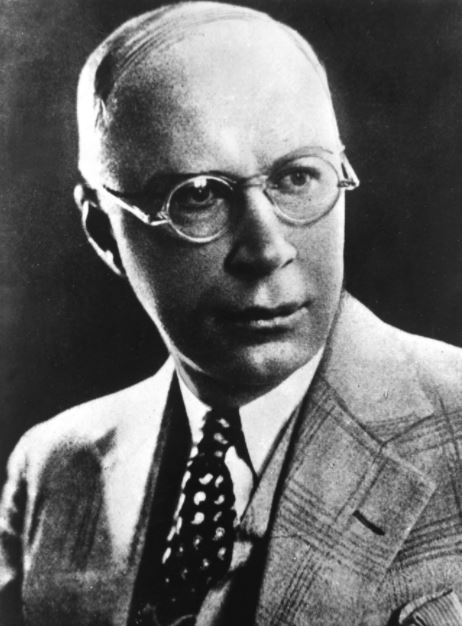
Dmitri Shoshakovich
He became a myth with the Siege of St. Petersburg
Shostakovich’s name will be forever associated with the city of Leningrad (St. Petersburg’s name during the Soviet Union period). In 1942, when the city was suffering in the stranglehold of the German siege, the Leningrad composer was working on his 7th Symphony, which he wanted to give to his beleaguered countrymen. Against his will, on Stalin’s orders, he was taken out of the city through a final loophole, where he finished writing the symphony.
The work quickly became known abroad, and Stalin, recognizing its symbolic significance, had the score airlifted over the German positions into the city center, where the conductor Eliasberg was to perform the symphony during the siege. The symphony was set for a large orchestra, but at the first rehearsal only 15 exhausted and emaciated musicians appeared, surviving on sawdust, horse and rat meat. Eliasberg tried to rehearse the work, but the trumpeter could not elicit a sound from his instrument due to weakness, and some musicians could barely hold their instruments. After 15 minutes, Eliasberg had to end the rehearsal.
The performance day during the siege
Now an appeal was made to the front-line soldiers. So the orchestra could be filled up and Eliasberg had to rehearse the highly complex work ready for performance with the assembled orchestra in 6 days. Before the performance began, a Soviet general was said to have bombed the German troops to ensure a trouble-free performance. Loudspeakers had been set up throughout the city so that residents and enemies could sense the population’s will to resist.
Listeners and musicians risked their lives with the performance, fortunately it could be performed without any disturbances and the final applause knew no end.
The first movement of the symphony is the most programmatic: after a carefree introduction (the pre-war idyll), an invasion motif, growing over 15 minutes, breaks in accompanied by drums (as in Ravel’s Bolero), symbolizing the enemy and oppression. Shostakovich used parts of the melody “Da geh ich zu Maxim” from Franz Lehár’s operetta The Merry Widow, which was one of Hitler’s favorite works, for the invasion motif.
In fact, Shostakovich had written this movement in peacetime, so the always ambiguous composer was also communicating a hidden message here. He remains ambiguous even when the rescuer enters, for the musical theme of the rescuer is hardly different from the aggressor.
Stalin thanked Shostakovich badly for this act, because only 4 years after the war Shostakovich (with Prokofiev and Khatchaturian) had to endure a show trial.
Dmitri Shostakovich as an air-raid soldier at the Leningrad Conservatory in World War 2:
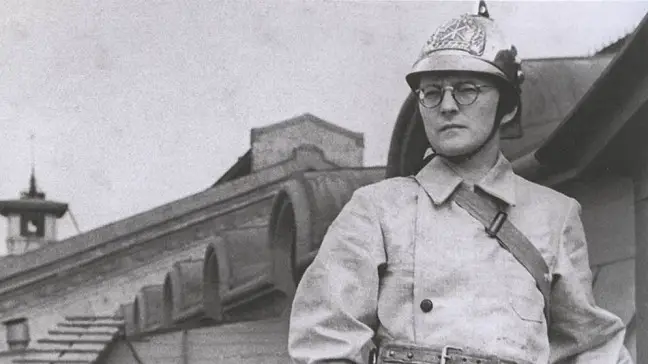
Concert of August 9, 1942:
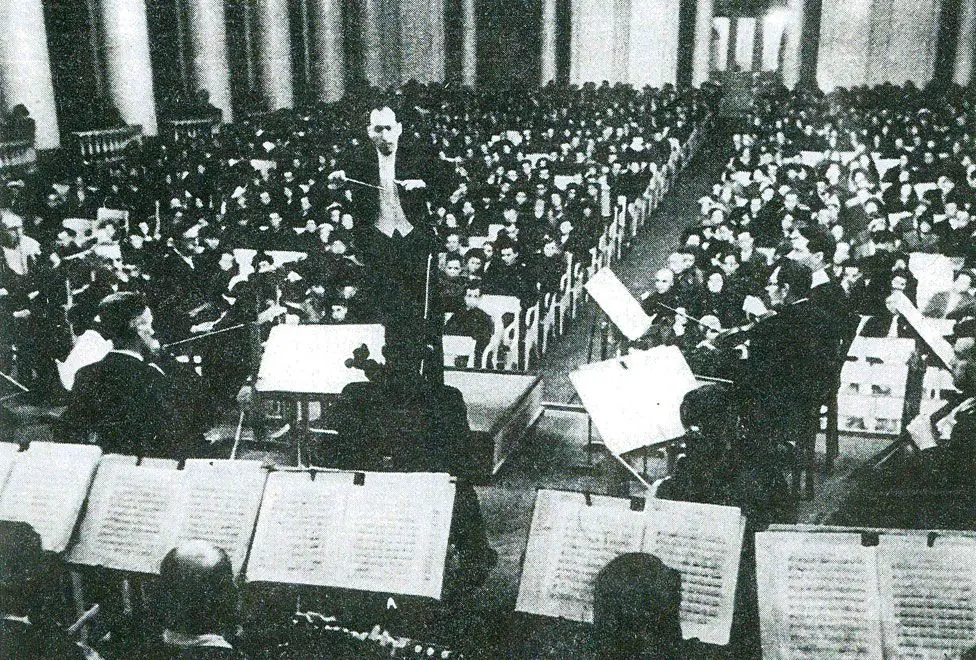
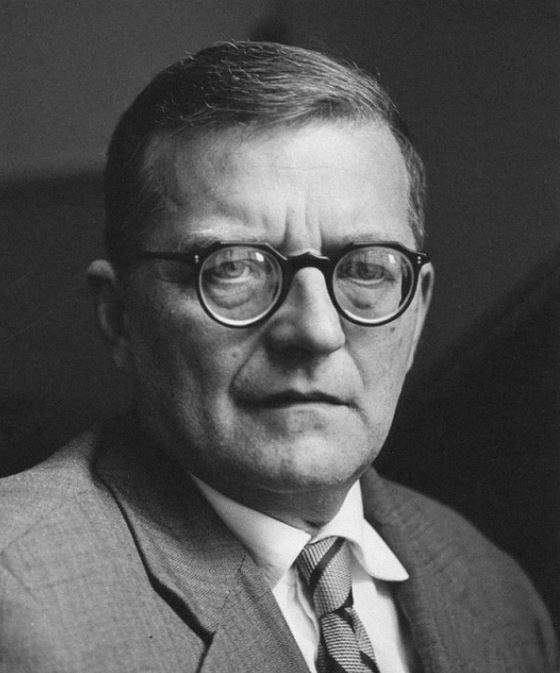
Johann Strauss
Johann Strauss visited Russia several times as a musician. His destination was Pavlovsk, where during the summer months he played music in a concert hall for the emperor, among others, and performed for balls.
Engaged by the Russian railroad company
The first Russian railroad line ran from St. Petersburg to the aristocratic palaces of Tsarskoye-Selo and Pavlovsk, 30 km to the south. The railroad line was put into operation in 1836, and in 1856 it engaged for the first time Johann Strauss and his orchestra to attract a wealthy class to Pavlov in the summer with their music and balls to promote the railroad line. To this end, the station building was turned into an entertainment palace, modeled on London’s Vauxhall, where restaurants and ballrooms invited visitors. The Strauss brothers subsequently played with a band in Pavlovsk almost daily from 1856 to 1865 and in 1869 from May to October. Strauss composed some pieces like the Pizzicato Waltz especially for this place.
The historical station building and pavilion, which were next to the palace, no longer exist, they were destroyed during the German occupation in World War II. Today, Pavlov Palace with its wonderful gardens still reminds us of this Belle Époque period.
The historic pavilion:
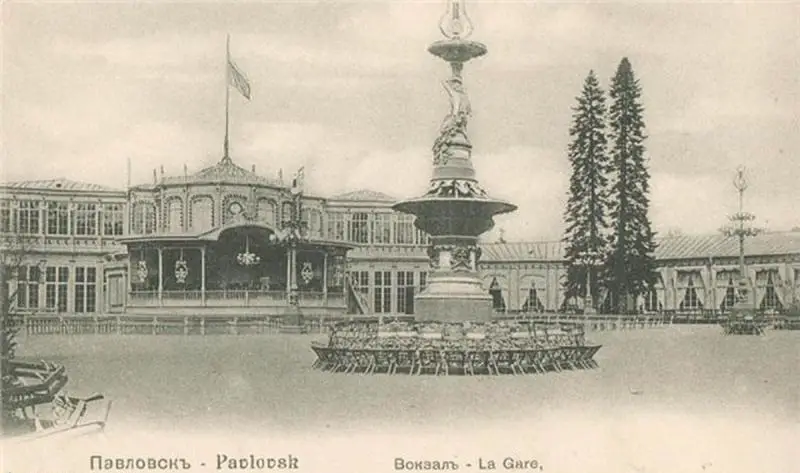
Pavlovsk Castle:
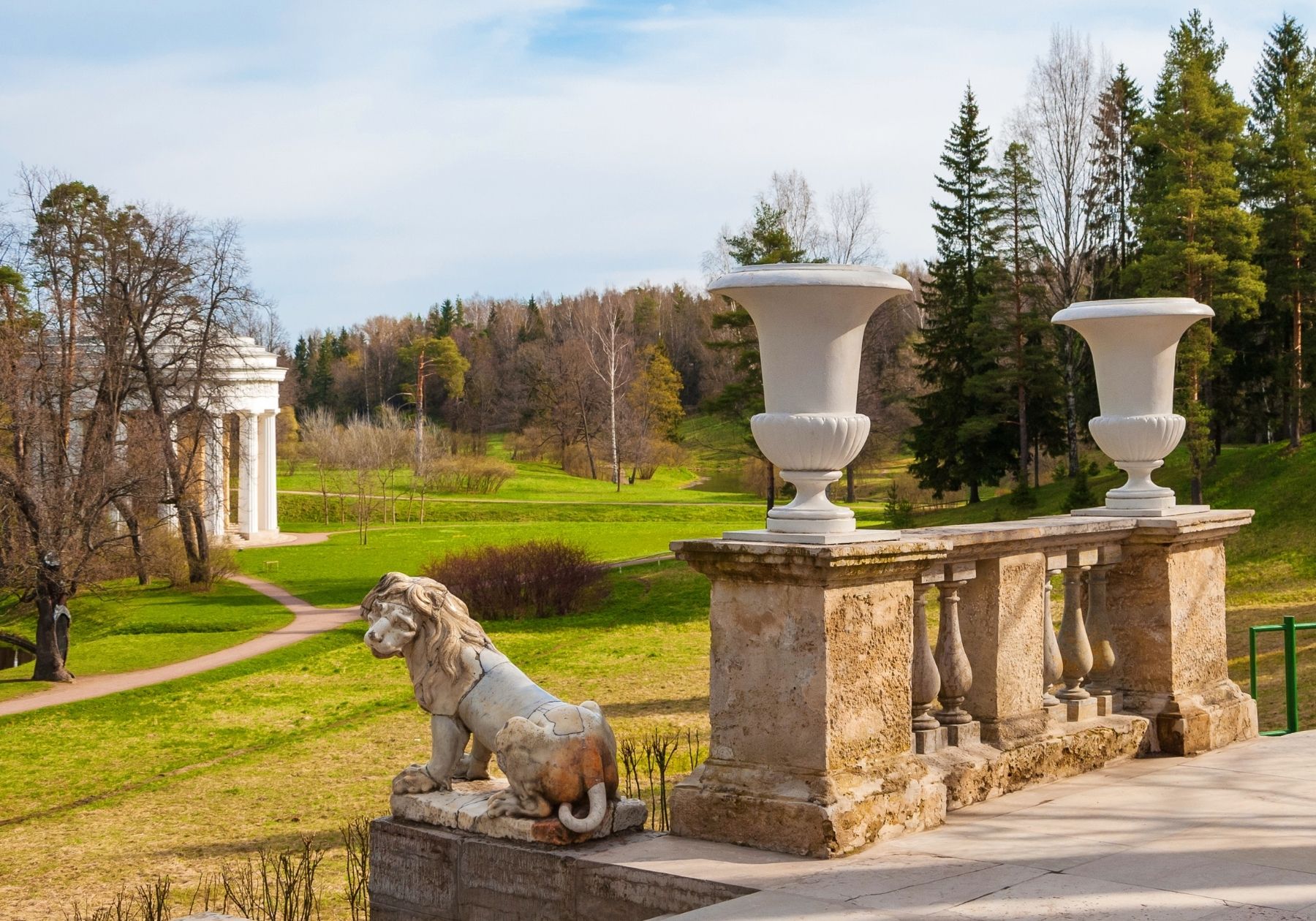
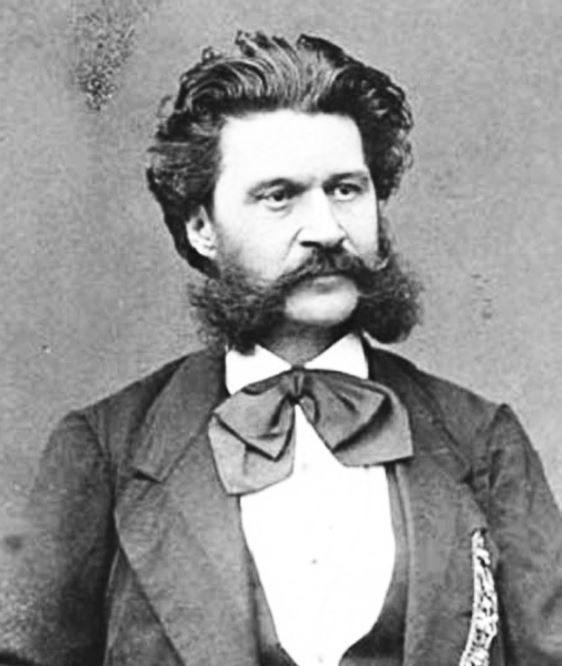
Sergei Rachmaninov
Lost the estates twice
Sergey grew up in the countryside in his early years as the scion of a wealthy family. But as the years went by, his parents lost their land holdings through incapacity, and while still a boy, Rachmaninov moved to Moscow with his mother, impoverished. There the pedagogue and conservatory teacher Sverev recognized his talent and let him live at his home, with free lodging and lessons. After his studies, Rachmaninov quickly established himself as a piano player and conductor, while his achievements as a composer, to his great regret, did not receive the recognition he had hoped for.
After several long visits to Germany, Rachmaninov returned to Russia as a conductor and lived in the country estate of Ivanova, which belonged to the parents of Rachmaninov’s wife, from 1910. Here, in addition to his posts, he found the peace he longed for and he composed, among other things, his 3rd Piano Concerto. The Rachmaninovs left Russia for the USA in the wake of the October Revolution and never returned to the beloved estate, which was looted in the revolution.
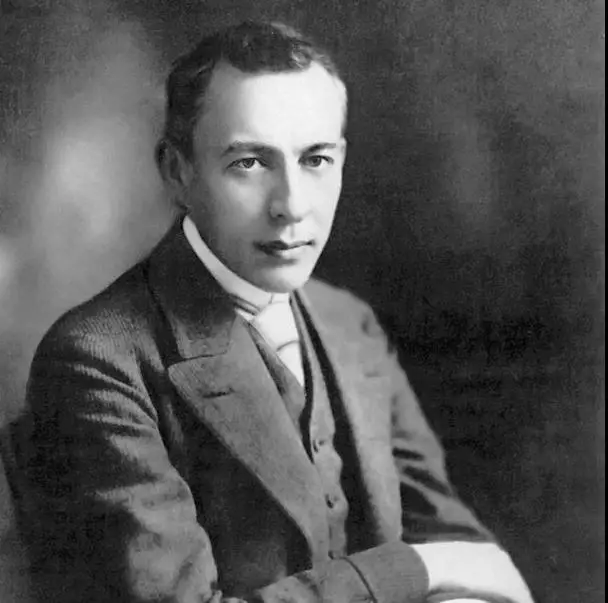
Peter Tchaikovsky
First years on a country estate
Tchaikovsky spent his earliest years on an estate in Votkinsk, where his father as the factory manager was granted a stately home. We know much about this period because Peter’s nanny Fanny Dürbach reported from this time in her memoirs. Tchaikowsky kept in touch with her and visited her in Montbéliard in 1892.
Traumatic move to St. Petersburg.
At the age of ten, Tchaikovsky experienced a traumatic event; to his horror, he was sent to a boarding school in St. Petersburg. With this event his childhood ends abruptly and he was prepared for a career as a civil servant.
At the age of 21, he leaft the civil service and began a career as a musician, penniless. He stayed in St. Petersburg for another 5 years and then went to Moscow, where he had his center of life as a teacher in the Conservatory. He returned to Leningrad countless times and finally died there only 53 years old.
The young Tchaikovsky:
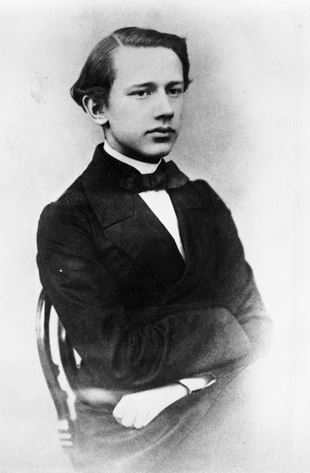
CONCERT HALLS AND OPERA HOUSES
Mikhail Glinka
The overfather of Russian music
Mikhail Glinka can be considered the forefather of Russian classical music. He spent most of his active life in St. Petersburg. The opera “A Life for the Tsar” of 1834 is considered the first independent Russian classical music and, consequently, the first Russian opera and had a decisive influence on the next generations of Russian musicians. It was the first opera whose story played in Russian and in which a man from the people played the leading role and not a nobleman, which was unheard of for that time.
Model for the mighty five
Rimsky-Korsakoff and the “mighty five”, in particular, embraced his legacy and established national Russian music (as opposed to the more Western-oriented Tchaikovsky). The work, as well as Glinka’s second important opera “Ruslan and Ludmila,” premiered at St. Petersburg’s Bolshoi Theater (not to be confused with Moscow’s), which was demolished in 1888 to make way for the new Conservatory.

Nikolai Rimsky-Korsakoff.
Member of the mighty five
Rimsky-Korsakoff held an immensely important position in 19th-century Russian musical life. He absorbed the ideas of Glinka, the first Russian composer, drew inspiration from Balakirev, Berlioz, and Liszt, and was a member of he St. Petersburg powerful group that championed national Russian music.
He especially supported and encouraged fellow composer Mussorgsky, whose “Boris Godunov” he twice reworked, for example. Among his students were such resounding names as Stravinsky, Glasunov, and Prokovieff. His best-known works are probably “Scheherazade,” a program music influenced by Liszt, and “the Flight of the Bumblebee” from one of his operas.
Korsakoff came from a wealthy family with an army tradition; he himself went to sea for three years in his officer training until he decided to pursue music.

Modest Mussorgsky
Mussorgsky in St. Petersburg
Mussorgsky spent most of his artistically productive years in St. Petersburg. He was born in 1839 400 km south of St. Petersburg. He arrived there at the age of 13 to begin his education at a cadet school, according to family tradition, with a later career as a civil servant.
However, he left this path at the age of 19 to devote himself to music, but kept working in civil service positions to make a living. Mussorgsky lived on and off in residential cooperatives, at times in the commune of the “Mighty Handful” (with Balakirev, Borodin, Cui, Rimsky-Korsakov). His alcohol consumption and lack of formal musical training prevented a larger oeuvre, but his compositions of “Pictures at an Exhibition”, “Boris Godunov” and “Night on the Bald Mountain” achieved world renown (listen below to a excursus on his opera “Boris Godunov”).
Mussorgsky in Moscow
Mussorgsky’s artistic center throughout his life was in St. Petersburg, but it was his first visit to Moscow at the age of 20 that made a deep impression on him and triggered a “love for everything Russian.”

Sergey Prokoffiev
Return to Moscow
An exiled Russian, Prokofiev had emigrated in the wake of the October Revolution and returned to Moscow in 1936 to remain permanently in the Soviet Union. This move still amazes many today, as he voluntarily submitted to the artistic constraints of Stalin’s Bolshevik dictatorship. The period that followed was artistically very productive and the hoped-for surge in creativity that the composer wished for when he returned home became a reality.
The Ukrainian-born composer did not return to St. Petersburg, but to Moscow, where, due to the political situation, the center of the art scene was located.
Privately, the time was less happy. In the second half of the forties he married again. The marriage with his Spanish wife, who had come to Moscow with him, was dissolved and she was imprisoned in an internment camp for 8 years, allegedly because she had transferred money to Spain to her mother, which was then forbidden.
After a fall down the stairs, Prokofiev’s health did not recover properly at the end of the forties, and a show trial, which he, Shoshakovich and Katchaturian were subjected to, was very hard on him. He finally died on the same day as Stalin, which is why no one took notice of his death and he was buried without festivity.

Dmitri Shoshakovich
He became a myth with the Siege of St. Petersburg
Shostakovich’s name will be forever associated with the city of Leningrad (St. Petersburg’s name during the Soviet Union period). In 1942, when the city was suffering in the stranglehold of the German siege, the Leningrad composer was working on his 7th Symphony, which he wanted to give to his beleaguered countrymen. Against his will, on Stalin’s orders, he was taken out of the city through a final loophole, where he finished writing the symphony.
The work quickly became known abroad, and Stalin, recognizing its symbolic significance, had the score airlifted over the German positions into the city center, where the conductor Eliasberg was to perform the symphony during the siege. The symphony was set for a large orchestra, but at the first rehearsal only 15 exhausted and emaciated musicians appeared, surviving on sawdust, horse and rat meat. Eliasberg tried to rehearse the work, but the trumpeter could not elicit a sound from his instrument due to weakness, and some musicians could barely hold their instruments. After 15 minutes, Eliasberg had to end the rehearsal.
The performance day during the siege
Now an appeal was made to the front-line soldiers. So the orchestra could be filled up and Eliasberg had to rehearse the highly complex work ready for performance with the assembled orchestra in 6 days. Before the performance began, a Soviet general was said to have bombed the German troops to ensure a trouble-free performance. Loudspeakers had been set up throughout the city so that residents and enemies could sense the population’s will to resist.
Listeners and musicians risked their lives with the performance, fortunately it could be performed without any disturbances and the final applause knew no end.
The first movement of the symphony is the most programmatic: after a carefree introduction (the pre-war idyll), an invasion motif, growing over 15 minutes, breaks in accompanied by drums (as in Ravel’s Bolero), symbolizing the enemy and oppression. Shostakovich used parts of the melody “Da geh ich zu Maxim” from Franz Lehár’s operetta The Merry Widow, which was one of Hitler’s favorite works, for the invasion motif.
In fact, Shostakovich had written this movement in peacetime, so the always ambiguous composer was also communicating a hidden message here. He remains ambiguous even when the rescuer enters, for the musical theme of the rescuer is hardly different from the aggressor.
Stalin thanked Shostakovich badly for this act, because only 4 years after the war Shostakovich (with Prokofiev and Khatchaturian) had to endure a show trial.
Dmitri Shostakovich as an air-raid soldier at the Leningrad Conservatory in World War 2:

Concert of August 9, 1942:


Johann Strauss
Johann Strauss visited Russia several times as a musician. His destination was Pavlovsk, where during the summer months he played music in a concert hall for the emperor, among others, and performed for balls.
Engaged by the Russian railroad company
The first Russian railroad line ran from St. Petersburg to the aristocratic palaces of Tsarskoye-Selo and Pavlovsk, 30 km to the south. The railroad line was put into operation in 1836, and in 1856 it engaged for the first time Johann Strauss and his orchestra to attract a wealthy class to Pavlov in the summer with their music and balls to promote the railroad line. To this end, the station building was turned into an entertainment palace, modeled on London’s Vauxhall, where restaurants and ballrooms invited visitors. The Strauss brothers subsequently played with a band in Pavlovsk almost daily from 1856 to 1865 and in 1869 from May to October. Strauss composed some pieces like the Pizzicato Waltz especially for this place.
The historical station building and pavilion, which were next to the palace, no longer exist, they were destroyed during the German occupation in World War II. Today, Pavlov Palace with its wonderful gardens still reminds us of this Belle Époque period.
The historic pavilion:

Pavlovsk Castle:


Sergei Rachmaninov
Lost the estates twice
Sergey grew up in the countryside in his early years as the scion of a wealthy family. But as the years went by, his parents lost their land holdings through incapacity, and while still a boy, Rachmaninov moved to Moscow with his mother, impoverished. There the pedagogue and conservatory teacher Sverev recognized his talent and let him live at his home, with free lodging and lessons. After his studies, Rachmaninov quickly established himself as a piano player and conductor, while his achievements as a composer, to his great regret, did not receive the recognition he had hoped for.
After several long visits to Germany, Rachmaninov returned to Russia as a conductor and lived in the country estate of Ivanova, which belonged to the parents of Rachmaninov’s wife, from 1910. Here, in addition to his posts, he found the peace he longed for and he composed, among other things, his 3rd Piano Concerto. The Rachmaninovs left Russia for the USA in the wake of the October Revolution and never returned to the beloved estate, which was looted in the revolution.

Peter Tchaikovsky
First years on a country estate
Tchaikovsky spent his earliest years on an estate in Votkinsk, where his father as the factory manager was granted a stately home. We know much about this period because Peter’s nanny Fanny Dürbach reported from this time in her memoirs. Tchaikowsky kept in touch with her and visited her in Montbéliard in 1892.
Traumatic move to St. Petersburg.
At the age of ten, Tchaikovsky experienced a traumatic event; to his horror, he was sent to a boarding school in St. Petersburg. With this event his childhood ends abruptly and he was prepared for a career as a civil servant.
At the age of 21, he leaft the civil service and began a career as a musician, penniless. He stayed in St. Petersburg for another 5 years and then went to Moscow, where he had his center of life as a teacher in the Conservatory. He returned to Leningrad countless times and finally died there only 53 years old.
The young Tchaikovsky:

MUSEUMS
Mikhail Glinka
The overfather of Russian music
Mikhail Glinka can be considered the forefather of Russian classical music. He spent most of his active life in St. Petersburg. The opera “A Life for the Tsar” of 1834 is considered the first independent Russian classical music and, consequently, the first Russian opera and had a decisive influence on the next generations of Russian musicians. It was the first opera whose story played in Russian and in which a man from the people played the leading role and not a nobleman, which was unheard of for that time.
Model for the mighty five
Rimsky-Korsakoff and the “mighty five”, in particular, embraced his legacy and established national Russian music (as opposed to the more Western-oriented Tchaikovsky). The work, as well as Glinka’s second important opera “Ruslan and Ludmila,” premiered at St. Petersburg’s Bolshoi Theater (not to be confused with Moscow’s), which was demolished in 1888 to make way for the new Conservatory.

Nikolai Rimsky-Korsakoff.
Member of the mighty five
Rimsky-Korsakoff held an immensely important position in 19th-century Russian musical life. He absorbed the ideas of Glinka, the first Russian composer, drew inspiration from Balakirev, Berlioz, and Liszt, and was a member of he St. Petersburg powerful group that championed national Russian music.
He especially supported and encouraged fellow composer Mussorgsky, whose “Boris Godunov” he twice reworked, for example. Among his students were such resounding names as Stravinsky, Glasunov, and Prokovieff. His best-known works are probably “Scheherazade,” a program music influenced by Liszt, and “the Flight of the Bumblebee” from one of his operas.
Korsakoff came from a wealthy family with an army tradition; he himself went to sea for three years in his officer training until he decided to pursue music.

Modest Mussorgsky
Mussorgsky in St. Petersburg
Mussorgsky spent most of his artistically productive years in St. Petersburg. He was born in 1839 400 km south of St. Petersburg. He arrived there at the age of 13 to begin his education at a cadet school, according to family tradition, with a later career as a civil servant.
However, he left this path at the age of 19 to devote himself to music, but kept working in civil service positions to make a living. Mussorgsky lived on and off in residential cooperatives, at times in the commune of the “Mighty Handful” (with Balakirev, Borodin, Cui, Rimsky-Korsakov). His alcohol consumption and lack of formal musical training prevented a larger oeuvre, but his compositions of “Pictures at an Exhibition”, “Boris Godunov” and “Night on the Bald Mountain” achieved world renown (listen below to a excursus on his opera “Boris Godunov”).
Mussorgsky in Moscow
Mussorgsky’s artistic center throughout his life was in St. Petersburg, but it was his first visit to Moscow at the age of 20 that made a deep impression on him and triggered a “love for everything Russian.”

Sergey Prokoffiev
Return to Moscow
An exiled Russian, Prokofiev had emigrated in the wake of the October Revolution and returned to Moscow in 1936 to remain permanently in the Soviet Union. This move still amazes many today, as he voluntarily submitted to the artistic constraints of Stalin’s Bolshevik dictatorship. The period that followed was artistically very productive and the hoped-for surge in creativity that the composer wished for when he returned home became a reality.
The Ukrainian-born composer did not return to St. Petersburg, but to Moscow, where, due to the political situation, the center of the art scene was located.
Privately, the time was less happy. In the second half of the forties he married again. The marriage with his Spanish wife, who had come to Moscow with him, was dissolved and she was imprisoned in an internment camp for 8 years, allegedly because she had transferred money to Spain to her mother, which was then forbidden.
After a fall down the stairs, Prokofiev’s health did not recover properly at the end of the forties, and a show trial, which he, Shoshakovich and Katchaturian were subjected to, was very hard on him. He finally died on the same day as Stalin, which is why no one took notice of his death and he was buried without festivity.

Dmitri Shoshakovich
He became a myth with the Siege of St. Petersburg
Shostakovich’s name will be forever associated with the city of Leningrad (St. Petersburg’s name during the Soviet Union period). In 1942, when the city was suffering in the stranglehold of the German siege, the Leningrad composer was working on his 7th Symphony, which he wanted to give to his beleaguered countrymen. Against his will, on Stalin’s orders, he was taken out of the city through a final loophole, where he finished writing the symphony.
The work quickly became known abroad, and Stalin, recognizing its symbolic significance, had the score airlifted over the German positions into the city center, where the conductor Eliasberg was to perform the symphony during the siege. The symphony was set for a large orchestra, but at the first rehearsal only 15 exhausted and emaciated musicians appeared, surviving on sawdust, horse and rat meat. Eliasberg tried to rehearse the work, but the trumpeter could not elicit a sound from his instrument due to weakness, and some musicians could barely hold their instruments. After 15 minutes, Eliasberg had to end the rehearsal.
The performance day during the siege
Now an appeal was made to the front-line soldiers. So the orchestra could be filled up and Eliasberg had to rehearse the highly complex work ready for performance with the assembled orchestra in 6 days. Before the performance began, a Soviet general was said to have bombed the German troops to ensure a trouble-free performance. Loudspeakers had been set up throughout the city so that residents and enemies could sense the population’s will to resist.
Listeners and musicians risked their lives with the performance, fortunately it could be performed without any disturbances and the final applause knew no end.
The first movement of the symphony is the most programmatic: after a carefree introduction (the pre-war idyll), an invasion motif, growing over 15 minutes, breaks in accompanied by drums (as in Ravel’s Bolero), symbolizing the enemy and oppression. Shostakovich used parts of the melody “Da geh ich zu Maxim” from Franz Lehár’s operetta The Merry Widow, which was one of Hitler’s favorite works, for the invasion motif.
In fact, Shostakovich had written this movement in peacetime, so the always ambiguous composer was also communicating a hidden message here. He remains ambiguous even when the rescuer enters, for the musical theme of the rescuer is hardly different from the aggressor.
Stalin thanked Shostakovich badly for this act, because only 4 years after the war Shostakovich (with Prokofiev and Khatchaturian) had to endure a show trial.
Dmitri Shostakovich as an air-raid soldier at the Leningrad Conservatory in World War 2:

Concert of August 9, 1942:


Johann Strauss
Johann Strauss visited Russia several times as a musician. His destination was Pavlovsk, where during the summer months he played music in a concert hall for the emperor, among others, and performed for balls.
Engaged by the Russian railroad company
The first Russian railroad line ran from St. Petersburg to the aristocratic palaces of Tsarskoye-Selo and Pavlovsk, 30 km to the south. The railroad line was put into operation in 1836, and in 1856 it engaged for the first time Johann Strauss and his orchestra to attract a wealthy class to Pavlov in the summer with their music and balls to promote the railroad line. To this end, the station building was turned into an entertainment palace, modeled on London’s Vauxhall, where restaurants and ballrooms invited visitors. The Strauss brothers subsequently played with a band in Pavlovsk almost daily from 1856 to 1865 and in 1869 from May to October. Strauss composed some pieces like the Pizzicato Waltz especially for this place.
The historical station building and pavilion, which were next to the palace, no longer exist, they were destroyed during the German occupation in World War II. Today, Pavlov Palace with its wonderful gardens still reminds us of this Belle Époque period.
The historic pavilion:

Pavlovsk Castle:


Sergei Rachmaninov
Lost the estates twice
Sergey grew up in the countryside in his early years as the scion of a wealthy family. But as the years went by, his parents lost their land holdings through incapacity, and while still a boy, Rachmaninov moved to Moscow with his mother, impoverished. There the pedagogue and conservatory teacher Sverev recognized his talent and let him live at his home, with free lodging and lessons. After his studies, Rachmaninov quickly established himself as a piano player and conductor, while his achievements as a composer, to his great regret, did not receive the recognition he had hoped for.
After several long visits to Germany, Rachmaninov returned to Russia as a conductor and lived in the country estate of Ivanova, which belonged to the parents of Rachmaninov’s wife, from 1910. Here, in addition to his posts, he found the peace he longed for and he composed, among other things, his 3rd Piano Concerto. The Rachmaninovs left Russia for the USA in the wake of the October Revolution and never returned to the beloved estate, which was looted in the revolution.

Peter Tchaikovsky
First years on a country estate
Tchaikovsky spent his earliest years on an estate in Votkinsk, where his father as the factory manager was granted a stately home. We know much about this period because Peter’s nanny Fanny Dürbach reported from this time in her memoirs. Tchaikowsky kept in touch with her and visited her in Montbéliard in 1892.
Traumatic move to St. Petersburg.
At the age of ten, Tchaikovsky experienced a traumatic event; to his horror, he was sent to a boarding school in St. Petersburg. With this event his childhood ends abruptly and he was prepared for a career as a civil servant.
At the age of 21, he leaft the civil service and began a career as a musician, penniless. He stayed in St. Petersburg for another 5 years and then went to Moscow, where he had his center of life as a teacher in the Conservatory. He returned to Leningrad countless times and finally died there only 53 years old.
The young Tchaikovsky:

HOUSES AND APARTMENT OF ARTISTS
Mikhail Glinka
The overfather of Russian music
Mikhail Glinka can be considered the forefather of Russian classical music. He spent most of his active life in St. Petersburg. The opera “A Life for the Tsar” of 1834 is considered the first independent Russian classical music and, consequently, the first Russian opera and had a decisive influence on the next generations of Russian musicians. It was the first opera whose story played in Russian and in which a man from the people played the leading role and not a nobleman, which was unheard of for that time.
Model for the mighty five
Rimsky-Korsakoff and the “mighty five”, in particular, embraced his legacy and established national Russian music (as opposed to the more Western-oriented Tchaikovsky). The work, as well as Glinka’s second important opera “Ruslan and Ludmila,” premiered at St. Petersburg’s Bolshoi Theater (not to be confused with Moscow’s), which was demolished in 1888 to make way for the new Conservatory.

Nikolai Rimsky-Korsakoff.
Member of the mighty five
Rimsky-Korsakoff held an immensely important position in 19th-century Russian musical life. He absorbed the ideas of Glinka, the first Russian composer, drew inspiration from Balakirev, Berlioz, and Liszt, and was a member of he St. Petersburg powerful group that championed national Russian music.
He especially supported and encouraged fellow composer Mussorgsky, whose “Boris Godunov” he twice reworked, for example. Among his students were such resounding names as Stravinsky, Glasunov, and Prokovieff. His best-known works are probably “Scheherazade,” a program music influenced by Liszt, and “the Flight of the Bumblebee” from one of his operas.
Korsakoff came from a wealthy family with an army tradition; he himself went to sea for three years in his officer training until he decided to pursue music.

Modest Mussorgsky
Mussorgsky in St. Petersburg
Mussorgsky spent most of his artistically productive years in St. Petersburg. He was born in 1839 400 km south of St. Petersburg. He arrived there at the age of 13 to begin his education at a cadet school, according to family tradition, with a later career as a civil servant.
However, he left this path at the age of 19 to devote himself to music, but kept working in civil service positions to make a living. Mussorgsky lived on and off in residential cooperatives, at times in the commune of the “Mighty Handful” (with Balakirev, Borodin, Cui, Rimsky-Korsakov). His alcohol consumption and lack of formal musical training prevented a larger oeuvre, but his compositions of “Pictures at an Exhibition”, “Boris Godunov” and “Night on the Bald Mountain” achieved world renown (listen below to a excursus on his opera “Boris Godunov”).
Mussorgsky in Moscow
Mussorgsky’s artistic center throughout his life was in St. Petersburg, but it was his first visit to Moscow at the age of 20 that made a deep impression on him and triggered a “love for everything Russian.”

Sergey Prokoffiev
Return to Moscow
An exiled Russian, Prokofiev had emigrated in the wake of the October Revolution and returned to Moscow in 1936 to remain permanently in the Soviet Union. This move still amazes many today, as he voluntarily submitted to the artistic constraints of Stalin’s Bolshevik dictatorship. The period that followed was artistically very productive and the hoped-for surge in creativity that the composer wished for when he returned home became a reality.
The Ukrainian-born composer did not return to St. Petersburg, but to Moscow, where, due to the political situation, the center of the art scene was located.
Privately, the time was less happy. In the second half of the forties he married again. The marriage with his Spanish wife, who had come to Moscow with him, was dissolved and she was imprisoned in an internment camp for 8 years, allegedly because she had transferred money to Spain to her mother, which was then forbidden.
After a fall down the stairs, Prokofiev’s health did not recover properly at the end of the forties, and a show trial, which he, Shoshakovich and Katchaturian were subjected to, was very hard on him. He finally died on the same day as Stalin, which is why no one took notice of his death and he was buried without festivity.

Dmitri Shoshakovich
He became a myth with the Siege of St. Petersburg
Shostakovich’s name will be forever associated with the city of Leningrad (St. Petersburg’s name during the Soviet Union period). In 1942, when the city was suffering in the stranglehold of the German siege, the Leningrad composer was working on his 7th Symphony, which he wanted to give to his beleaguered countrymen. Against his will, on Stalin’s orders, he was taken out of the city through a final loophole, where he finished writing the symphony.
The work quickly became known abroad, and Stalin, recognizing its symbolic significance, had the score airlifted over the German positions into the city center, where the conductor Eliasberg was to perform the symphony during the siege. The symphony was set for a large orchestra, but at the first rehearsal only 15 exhausted and emaciated musicians appeared, surviving on sawdust, horse and rat meat. Eliasberg tried to rehearse the work, but the trumpeter could not elicit a sound from his instrument due to weakness, and some musicians could barely hold their instruments. After 15 minutes, Eliasberg had to end the rehearsal.
The performance day during the siege
Now an appeal was made to the front-line soldiers. So the orchestra could be filled up and Eliasberg had to rehearse the highly complex work ready for performance with the assembled orchestra in 6 days. Before the performance began, a Soviet general was said to have bombed the German troops to ensure a trouble-free performance. Loudspeakers had been set up throughout the city so that residents and enemies could sense the population’s will to resist.
Listeners and musicians risked their lives with the performance, fortunately it could be performed without any disturbances and the final applause knew no end.
The first movement of the symphony is the most programmatic: after a carefree introduction (the pre-war idyll), an invasion motif, growing over 15 minutes, breaks in accompanied by drums (as in Ravel’s Bolero), symbolizing the enemy and oppression. Shostakovich used parts of the melody “Da geh ich zu Maxim” from Franz Lehár’s operetta The Merry Widow, which was one of Hitler’s favorite works, for the invasion motif.
In fact, Shostakovich had written this movement in peacetime, so the always ambiguous composer was also communicating a hidden message here. He remains ambiguous even when the rescuer enters, for the musical theme of the rescuer is hardly different from the aggressor.
Stalin thanked Shostakovich badly for this act, because only 4 years after the war Shostakovich (with Prokofiev and Khatchaturian) had to endure a show trial.
Dmitri Shostakovich as an air-raid soldier at the Leningrad Conservatory in World War 2:

Concert of August 9, 1942:


Johann Strauss
Johann Strauss visited Russia several times as a musician. His destination was Pavlovsk, where during the summer months he played music in a concert hall for the emperor, among others, and performed for balls.
Engaged by the Russian railroad company
The first Russian railroad line ran from St. Petersburg to the aristocratic palaces of Tsarskoye-Selo and Pavlovsk, 30 km to the south. The railroad line was put into operation in 1836, and in 1856 it engaged for the first time Johann Strauss and his orchestra to attract a wealthy class to Pavlov in the summer with their music and balls to promote the railroad line. To this end, the station building was turned into an entertainment palace, modeled on London’s Vauxhall, where restaurants and ballrooms invited visitors. The Strauss brothers subsequently played with a band in Pavlovsk almost daily from 1856 to 1865 and in 1869 from May to October. Strauss composed some pieces like the Pizzicato Waltz especially for this place.
The historical station building and pavilion, which were next to the palace, no longer exist, they were destroyed during the German occupation in World War II. Today, Pavlov Palace with its wonderful gardens still reminds us of this Belle Époque period.
The historic pavilion:

Pavlovsk Castle:


Sergei Rachmaninov
Lost the estates twice
Sergey grew up in the countryside in his early years as the scion of a wealthy family. But as the years went by, his parents lost their land holdings through incapacity, and while still a boy, Rachmaninov moved to Moscow with his mother, impoverished. There the pedagogue and conservatory teacher Sverev recognized his talent and let him live at his home, with free lodging and lessons. After his studies, Rachmaninov quickly established himself as a piano player and conductor, while his achievements as a composer, to his great regret, did not receive the recognition he had hoped for.
After several long visits to Germany, Rachmaninov returned to Russia as a conductor and lived in the country estate of Ivanova, which belonged to the parents of Rachmaninov’s wife, from 1910. Here, in addition to his posts, he found the peace he longed for and he composed, among other things, his 3rd Piano Concerto. The Rachmaninovs left Russia for the USA in the wake of the October Revolution and never returned to the beloved estate, which was looted in the revolution.

Peter Tchaikovsky
First years on a country estate
Tchaikovsky spent his earliest years on an estate in Votkinsk, where his father as the factory manager was granted a stately home. We know much about this period because Peter’s nanny Fanny Dürbach reported from this time in her memoirs. Tchaikowsky kept in touch with her and visited her in Montbéliard in 1892.
Traumatic move to St. Petersburg.
At the age of ten, Tchaikovsky experienced a traumatic event; to his horror, he was sent to a boarding school in St. Petersburg. With this event his childhood ends abruptly and he was prepared for a career as a civil servant.
At the age of 21, he leaft the civil service and began a career as a musician, penniless. He stayed in St. Petersburg for another 5 years and then went to Moscow, where he had his center of life as a teacher in the Conservatory. He returned to Leningrad countless times and finally died there only 53 years old.
The young Tchaikovsky:

MONUMENTS
Mikhail Glinka
The overfather of Russian music
Mikhail Glinka can be considered the forefather of Russian classical music. He spent most of his active life in St. Petersburg. The opera “A Life for the Tsar” of 1834 is considered the first independent Russian classical music and, consequently, the first Russian opera and had a decisive influence on the next generations of Russian musicians. It was the first opera whose story played in Russian and in which a man from the people played the leading role and not a nobleman, which was unheard of for that time.
Model for the mighty five
Rimsky-Korsakoff and the “mighty five”, in particular, embraced his legacy and established national Russian music (as opposed to the more Western-oriented Tchaikovsky). The work, as well as Glinka’s second important opera “Ruslan and Ludmila,” premiered at St. Petersburg’s Bolshoi Theater (not to be confused with Moscow’s), which was demolished in 1888 to make way for the new Conservatory.

Nikolai Rimsky-Korsakoff.
Member of the mighty five
Rimsky-Korsakoff held an immensely important position in 19th-century Russian musical life. He absorbed the ideas of Glinka, the first Russian composer, drew inspiration from Balakirev, Berlioz, and Liszt, and was a member of he St. Petersburg powerful group that championed national Russian music.
He especially supported and encouraged fellow composer Mussorgsky, whose “Boris Godunov” he twice reworked, for example. Among his students were such resounding names as Stravinsky, Glasunov, and Prokovieff. His best-known works are probably “Scheherazade,” a program music influenced by Liszt, and “the Flight of the Bumblebee” from one of his operas.
Korsakoff came from a wealthy family with an army tradition; he himself went to sea for three years in his officer training until he decided to pursue music.

Modest Mussorgsky
Mussorgsky in St. Petersburg
Mussorgsky spent most of his artistically productive years in St. Petersburg. He was born in 1839 400 km south of St. Petersburg. He arrived there at the age of 13 to begin his education at a cadet school, according to family tradition, with a later career as a civil servant.
However, he left this path at the age of 19 to devote himself to music, but kept working in civil service positions to make a living. Mussorgsky lived on and off in residential cooperatives, at times in the commune of the “Mighty Handful” (with Balakirev, Borodin, Cui, Rimsky-Korsakov). His alcohol consumption and lack of formal musical training prevented a larger oeuvre, but his compositions of “Pictures at an Exhibition”, “Boris Godunov” and “Night on the Bald Mountain” achieved world renown (listen below to a excursus on his opera “Boris Godunov”).
Mussorgsky in Moscow
Mussorgsky’s artistic center throughout his life was in St. Petersburg, but it was his first visit to Moscow at the age of 20 that made a deep impression on him and triggered a “love for everything Russian.”

Sergey Prokoffiev
Return to Moscow
An exiled Russian, Prokofiev had emigrated in the wake of the October Revolution and returned to Moscow in 1936 to remain permanently in the Soviet Union. This move still amazes many today, as he voluntarily submitted to the artistic constraints of Stalin’s Bolshevik dictatorship. The period that followed was artistically very productive and the hoped-for surge in creativity that the composer wished for when he returned home became a reality.
The Ukrainian-born composer did not return to St. Petersburg, but to Moscow, where, due to the political situation, the center of the art scene was located.
Privately, the time was less happy. In the second half of the forties he married again. The marriage with his Spanish wife, who had come to Moscow with him, was dissolved and she was imprisoned in an internment camp for 8 years, allegedly because she had transferred money to Spain to her mother, which was then forbidden.
After a fall down the stairs, Prokofiev’s health did not recover properly at the end of the forties, and a show trial, which he, Shoshakovich and Katchaturian were subjected to, was very hard on him. He finally died on the same day as Stalin, which is why no one took notice of his death and he was buried without festivity.

Dmitri Shoshakovich
He became a myth with the Siege of St. Petersburg
Shostakovich’s name will be forever associated with the city of Leningrad (St. Petersburg’s name during the Soviet Union period). In 1942, when the city was suffering in the stranglehold of the German siege, the Leningrad composer was working on his 7th Symphony, which he wanted to give to his beleaguered countrymen. Against his will, on Stalin’s orders, he was taken out of the city through a final loophole, where he finished writing the symphony.
The work quickly became known abroad, and Stalin, recognizing its symbolic significance, had the score airlifted over the German positions into the city center, where the conductor Eliasberg was to perform the symphony during the siege. The symphony was set for a large orchestra, but at the first rehearsal only 15 exhausted and emaciated musicians appeared, surviving on sawdust, horse and rat meat. Eliasberg tried to rehearse the work, but the trumpeter could not elicit a sound from his instrument due to weakness, and some musicians could barely hold their instruments. After 15 minutes, Eliasberg had to end the rehearsal.
The performance day during the siege
Now an appeal was made to the front-line soldiers. So the orchestra could be filled up and Eliasberg had to rehearse the highly complex work ready for performance with the assembled orchestra in 6 days. Before the performance began, a Soviet general was said to have bombed the German troops to ensure a trouble-free performance. Loudspeakers had been set up throughout the city so that residents and enemies could sense the population’s will to resist.
Listeners and musicians risked their lives with the performance, fortunately it could be performed without any disturbances and the final applause knew no end.
The first movement of the symphony is the most programmatic: after a carefree introduction (the pre-war idyll), an invasion motif, growing over 15 minutes, breaks in accompanied by drums (as in Ravel’s Bolero), symbolizing the enemy and oppression. Shostakovich used parts of the melody “Da geh ich zu Maxim” from Franz Lehár’s operetta The Merry Widow, which was one of Hitler’s favorite works, for the invasion motif.
In fact, Shostakovich had written this movement in peacetime, so the always ambiguous composer was also communicating a hidden message here. He remains ambiguous even when the rescuer enters, for the musical theme of the rescuer is hardly different from the aggressor.
Stalin thanked Shostakovich badly for this act, because only 4 years after the war Shostakovich (with Prokofiev and Khatchaturian) had to endure a show trial.
Dmitri Shostakovich as an air-raid soldier at the Leningrad Conservatory in World War 2:

Concert of August 9, 1942:


Johann Strauss
Johann Strauss visited Russia several times as a musician. His destination was Pavlovsk, where during the summer months he played music in a concert hall for the emperor, among others, and performed for balls.
Engaged by the Russian railroad company
The first Russian railroad line ran from St. Petersburg to the aristocratic palaces of Tsarskoye-Selo and Pavlovsk, 30 km to the south. The railroad line was put into operation in 1836, and in 1856 it engaged for the first time Johann Strauss and his orchestra to attract a wealthy class to Pavlov in the summer with their music and balls to promote the railroad line. To this end, the station building was turned into an entertainment palace, modeled on London’s Vauxhall, where restaurants and ballrooms invited visitors. The Strauss brothers subsequently played with a band in Pavlovsk almost daily from 1856 to 1865 and in 1869 from May to October. Strauss composed some pieces like the Pizzicato Waltz especially for this place.
The historical station building and pavilion, which were next to the palace, no longer exist, they were destroyed during the German occupation in World War II. Today, Pavlov Palace with its wonderful gardens still reminds us of this Belle Époque period.
The historic pavilion:

Pavlovsk Castle:


Sergei Rachmaninov
Lost the estates twice
Sergey grew up in the countryside in his early years as the scion of a wealthy family. But as the years went by, his parents lost their land holdings through incapacity, and while still a boy, Rachmaninov moved to Moscow with his mother, impoverished. There the pedagogue and conservatory teacher Sverev recognized his talent and let him live at his home, with free lodging and lessons. After his studies, Rachmaninov quickly established himself as a piano player and conductor, while his achievements as a composer, to his great regret, did not receive the recognition he had hoped for.
After several long visits to Germany, Rachmaninov returned to Russia as a conductor and lived in the country estate of Ivanova, which belonged to the parents of Rachmaninov’s wife, from 1910. Here, in addition to his posts, he found the peace he longed for and he composed, among other things, his 3rd Piano Concerto. The Rachmaninovs left Russia for the USA in the wake of the October Revolution and never returned to the beloved estate, which was looted in the revolution.

Peter Tchaikovsky
First years on a country estate
Tchaikovsky spent his earliest years on an estate in Votkinsk, where his father as the factory manager was granted a stately home. We know much about this period because Peter’s nanny Fanny Dürbach reported from this time in her memoirs. Tchaikowsky kept in touch with her and visited her in Montbéliard in 1892.
Traumatic move to St. Petersburg.
At the age of ten, Tchaikovsky experienced a traumatic event; to his horror, he was sent to a boarding school in St. Petersburg. With this event his childhood ends abruptly and he was prepared for a career as a civil servant.
At the age of 21, he leaft the civil service and began a career as a musician, penniless. He stayed in St. Petersburg for another 5 years and then went to Moscow, where he had his center of life as a teacher in the Conservatory. He returned to Leningrad countless times and finally died there only 53 years old.
The young Tchaikovsky:

RESTAURANT
Mikhail Glinka
The overfather of Russian music
Mikhail Glinka can be considered the forefather of Russian classical music. He spent most of his active life in St. Petersburg. The opera “A Life for the Tsar” of 1834 is considered the first independent Russian classical music and, consequently, the first Russian opera and had a decisive influence on the next generations of Russian musicians. It was the first opera whose story played in Russian and in which a man from the people played the leading role and not a nobleman, which was unheard of for that time.
Model for the mighty five
Rimsky-Korsakoff and the “mighty five”, in particular, embraced his legacy and established national Russian music (as opposed to the more Western-oriented Tchaikovsky). The work, as well as Glinka’s second important opera “Ruslan and Ludmila,” premiered at St. Petersburg’s Bolshoi Theater (not to be confused with Moscow’s), which was demolished in 1888 to make way for the new Conservatory.

Nikolai Rimsky-Korsakoff.
Member of the mighty five
Rimsky-Korsakoff held an immensely important position in 19th-century Russian musical life. He absorbed the ideas of Glinka, the first Russian composer, drew inspiration from Balakirev, Berlioz, and Liszt, and was a member of he St. Petersburg powerful group that championed national Russian music.
He especially supported and encouraged fellow composer Mussorgsky, whose “Boris Godunov” he twice reworked, for example. Among his students were such resounding names as Stravinsky, Glasunov, and Prokovieff. His best-known works are probably “Scheherazade,” a program music influenced by Liszt, and “the Flight of the Bumblebee” from one of his operas.
Korsakoff came from a wealthy family with an army tradition; he himself went to sea for three years in his officer training until he decided to pursue music.

Modest Mussorgsky
Mussorgsky in St. Petersburg
Mussorgsky spent most of his artistically productive years in St. Petersburg. He was born in 1839 400 km south of St. Petersburg. He arrived there at the age of 13 to begin his education at a cadet school, according to family tradition, with a later career as a civil servant.
However, he left this path at the age of 19 to devote himself to music, but kept working in civil service positions to make a living. Mussorgsky lived on and off in residential cooperatives, at times in the commune of the “Mighty Handful” (with Balakirev, Borodin, Cui, Rimsky-Korsakov). His alcohol consumption and lack of formal musical training prevented a larger oeuvre, but his compositions of “Pictures at an Exhibition”, “Boris Godunov” and “Night on the Bald Mountain” achieved world renown (listen below to a excursus on his opera “Boris Godunov”).
Mussorgsky in Moscow
Mussorgsky’s artistic center throughout his life was in St. Petersburg, but it was his first visit to Moscow at the age of 20 that made a deep impression on him and triggered a “love for everything Russian.”

Sergey Prokoffiev
Return to Moscow
An exiled Russian, Prokofiev had emigrated in the wake of the October Revolution and returned to Moscow in 1936 to remain permanently in the Soviet Union. This move still amazes many today, as he voluntarily submitted to the artistic constraints of Stalin’s Bolshevik dictatorship. The period that followed was artistically very productive and the hoped-for surge in creativity that the composer wished for when he returned home became a reality.
The Ukrainian-born composer did not return to St. Petersburg, but to Moscow, where, due to the political situation, the center of the art scene was located.
Privately, the time was less happy. In the second half of the forties he married again. The marriage with his Spanish wife, who had come to Moscow with him, was dissolved and she was imprisoned in an internment camp for 8 years, allegedly because she had transferred money to Spain to her mother, which was then forbidden.
After a fall down the stairs, Prokofiev’s health did not recover properly at the end of the forties, and a show trial, which he, Shoshakovich and Katchaturian were subjected to, was very hard on him. He finally died on the same day as Stalin, which is why no one took notice of his death and he was buried without festivity.

Dmitri Shoshakovich
He became a myth with the Siege of St. Petersburg
Shostakovich’s name will be forever associated with the city of Leningrad (St. Petersburg’s name during the Soviet Union period). In 1942, when the city was suffering in the stranglehold of the German siege, the Leningrad composer was working on his 7th Symphony, which he wanted to give to his beleaguered countrymen. Against his will, on Stalin’s orders, he was taken out of the city through a final loophole, where he finished writing the symphony.
The work quickly became known abroad, and Stalin, recognizing its symbolic significance, had the score airlifted over the German positions into the city center, where the conductor Eliasberg was to perform the symphony during the siege. The symphony was set for a large orchestra, but at the first rehearsal only 15 exhausted and emaciated musicians appeared, surviving on sawdust, horse and rat meat. Eliasberg tried to rehearse the work, but the trumpeter could not elicit a sound from his instrument due to weakness, and some musicians could barely hold their instruments. After 15 minutes, Eliasberg had to end the rehearsal.
The performance day during the siege
Now an appeal was made to the front-line soldiers. So the orchestra could be filled up and Eliasberg had to rehearse the highly complex work ready for performance with the assembled orchestra in 6 days. Before the performance began, a Soviet general was said to have bombed the German troops to ensure a trouble-free performance. Loudspeakers had been set up throughout the city so that residents and enemies could sense the population’s will to resist.
Listeners and musicians risked their lives with the performance, fortunately it could be performed without any disturbances and the final applause knew no end.
The first movement of the symphony is the most programmatic: after a carefree introduction (the pre-war idyll), an invasion motif, growing over 15 minutes, breaks in accompanied by drums (as in Ravel’s Bolero), symbolizing the enemy and oppression. Shostakovich used parts of the melody “Da geh ich zu Maxim” from Franz Lehár’s operetta The Merry Widow, which was one of Hitler’s favorite works, for the invasion motif.
In fact, Shostakovich had written this movement in peacetime, so the always ambiguous composer was also communicating a hidden message here. He remains ambiguous even when the rescuer enters, for the musical theme of the rescuer is hardly different from the aggressor.
Stalin thanked Shostakovich badly for this act, because only 4 years after the war Shostakovich (with Prokofiev and Khatchaturian) had to endure a show trial.
Dmitri Shostakovich as an air-raid soldier at the Leningrad Conservatory in World War 2:

Concert of August 9, 1942:


Johann Strauss
Johann Strauss visited Russia several times as a musician. His destination was Pavlovsk, where during the summer months he played music in a concert hall for the emperor, among others, and performed for balls.
Engaged by the Russian railroad company
The first Russian railroad line ran from St. Petersburg to the aristocratic palaces of Tsarskoye-Selo and Pavlovsk, 30 km to the south. The railroad line was put into operation in 1836, and in 1856 it engaged for the first time Johann Strauss and his orchestra to attract a wealthy class to Pavlov in the summer with their music and balls to promote the railroad line. To this end, the station building was turned into an entertainment palace, modeled on London’s Vauxhall, where restaurants and ballrooms invited visitors. The Strauss brothers subsequently played with a band in Pavlovsk almost daily from 1856 to 1865 and in 1869 from May to October. Strauss composed some pieces like the Pizzicato Waltz especially for this place.
The historical station building and pavilion, which were next to the palace, no longer exist, they were destroyed during the German occupation in World War II. Today, Pavlov Palace with its wonderful gardens still reminds us of this Belle Époque period.
The historic pavilion:

Pavlovsk Castle:


Sergei Rachmaninov
Lost the estates twice
Sergey grew up in the countryside in his early years as the scion of a wealthy family. But as the years went by, his parents lost their land holdings through incapacity, and while still a boy, Rachmaninov moved to Moscow with his mother, impoverished. There the pedagogue and conservatory teacher Sverev recognized his talent and let him live at his home, with free lodging and lessons. After his studies, Rachmaninov quickly established himself as a piano player and conductor, while his achievements as a composer, to his great regret, did not receive the recognition he had hoped for.
After several long visits to Germany, Rachmaninov returned to Russia as a conductor and lived in the country estate of Ivanova, which belonged to the parents of Rachmaninov’s wife, from 1910. Here, in addition to his posts, he found the peace he longed for and he composed, among other things, his 3rd Piano Concerto. The Rachmaninovs left Russia for the USA in the wake of the October Revolution and never returned to the beloved estate, which was looted in the revolution.

Peter Tchaikovsky
First years on a country estate
Tchaikovsky spent his earliest years on an estate in Votkinsk, where his father as the factory manager was granted a stately home. We know much about this period because Peter’s nanny Fanny Dürbach reported from this time in her memoirs. Tchaikowsky kept in touch with her and visited her in Montbéliard in 1892.
Traumatic move to St. Petersburg.
At the age of ten, Tchaikovsky experienced a traumatic event; to his horror, he was sent to a boarding school in St. Petersburg. With this event his childhood ends abruptly and he was prepared for a career as a civil servant.
At the age of 21, he leaft the civil service and began a career as a musician, penniless. He stayed in St. Petersburg for another 5 years and then went to Moscow, where he had his center of life as a teacher in the Conservatory. He returned to Leningrad countless times and finally died there only 53 years old.
The young Tchaikovsky:

CEMETERIES AND TOMBS OF FAMOUS MUSICIANS
Mikhail Glinka
The overfather of Russian music
Mikhail Glinka can be considered the forefather of Russian classical music. He spent most of his active life in St. Petersburg. The opera “A Life for the Tsar” of 1834 is considered the first independent Russian classical music and, consequently, the first Russian opera and had a decisive influence on the next generations of Russian musicians. It was the first opera whose story played in Russian and in which a man from the people played the leading role and not a nobleman, which was unheard of for that time.
Model for the mighty five
Rimsky-Korsakoff and the “mighty five”, in particular, embraced his legacy and established national Russian music (as opposed to the more Western-oriented Tchaikovsky). The work, as well as Glinka’s second important opera “Ruslan and Ludmila,” premiered at St. Petersburg’s Bolshoi Theater (not to be confused with Moscow’s), which was demolished in 1888 to make way for the new Conservatory.

Nikolai Rimsky-Korsakoff.
Member of the mighty five
Rimsky-Korsakoff held an immensely important position in 19th-century Russian musical life. He absorbed the ideas of Glinka, the first Russian composer, drew inspiration from Balakirev, Berlioz, and Liszt, and was a member of he St. Petersburg powerful group that championed national Russian music.
He especially supported and encouraged fellow composer Mussorgsky, whose “Boris Godunov” he twice reworked, for example. Among his students were such resounding names as Stravinsky, Glasunov, and Prokovieff. His best-known works are probably “Scheherazade,” a program music influenced by Liszt, and “the Flight of the Bumblebee” from one of his operas.
Korsakoff came from a wealthy family with an army tradition; he himself went to sea for three years in his officer training until he decided to pursue music.

Modest Mussorgsky
Mussorgsky in St. Petersburg
Mussorgsky spent most of his artistically productive years in St. Petersburg. He was born in 1839 400 km south of St. Petersburg. He arrived there at the age of 13 to begin his education at a cadet school, according to family tradition, with a later career as a civil servant.
However, he left this path at the age of 19 to devote himself to music, but kept working in civil service positions to make a living. Mussorgsky lived on and off in residential cooperatives, at times in the commune of the “Mighty Handful” (with Balakirev, Borodin, Cui, Rimsky-Korsakov). His alcohol consumption and lack of formal musical training prevented a larger oeuvre, but his compositions of “Pictures at an Exhibition”, “Boris Godunov” and “Night on the Bald Mountain” achieved world renown (listen below to a excursus on his opera “Boris Godunov”).
Mussorgsky in Moscow
Mussorgsky’s artistic center throughout his life was in St. Petersburg, but it was his first visit to Moscow at the age of 20 that made a deep impression on him and triggered a “love for everything Russian.”

Sergey Prokoffiev
Return to Moscow
An exiled Russian, Prokofiev had emigrated in the wake of the October Revolution and returned to Moscow in 1936 to remain permanently in the Soviet Union. This move still amazes many today, as he voluntarily submitted to the artistic constraints of Stalin’s Bolshevik dictatorship. The period that followed was artistically very productive and the hoped-for surge in creativity that the composer wished for when he returned home became a reality.
The Ukrainian-born composer did not return to St. Petersburg, but to Moscow, where, due to the political situation, the center of the art scene was located.
Privately, the time was less happy. In the second half of the forties he married again. The marriage with his Spanish wife, who had come to Moscow with him, was dissolved and she was imprisoned in an internment camp for 8 years, allegedly because she had transferred money to Spain to her mother, which was then forbidden.
After a fall down the stairs, Prokofiev’s health did not recover properly at the end of the forties, and a show trial, which he, Shoshakovich and Katchaturian were subjected to, was very hard on him. He finally died on the same day as Stalin, which is why no one took notice of his death and he was buried without festivity.

Dmitri Shoshakovich
He became a myth with the Siege of St. Petersburg
Shostakovich’s name will be forever associated with the city of Leningrad (St. Petersburg’s name during the Soviet Union period). In 1942, when the city was suffering in the stranglehold of the German siege, the Leningrad composer was working on his 7th Symphony, which he wanted to give to his beleaguered countrymen. Against his will, on Stalin’s orders, he was taken out of the city through a final loophole, where he finished writing the symphony.
The work quickly became known abroad, and Stalin, recognizing its symbolic significance, had the score airlifted over the German positions into the city center, where the conductor Eliasberg was to perform the symphony during the siege. The symphony was set for a large orchestra, but at the first rehearsal only 15 exhausted and emaciated musicians appeared, surviving on sawdust, horse and rat meat. Eliasberg tried to rehearse the work, but the trumpeter could not elicit a sound from his instrument due to weakness, and some musicians could barely hold their instruments. After 15 minutes, Eliasberg had to end the rehearsal.
The performance day during the siege
Now an appeal was made to the front-line soldiers. So the orchestra could be filled up and Eliasberg had to rehearse the highly complex work ready for performance with the assembled orchestra in 6 days. Before the performance began, a Soviet general was said to have bombed the German troops to ensure a trouble-free performance. Loudspeakers had been set up throughout the city so that residents and enemies could sense the population’s will to resist.
Listeners and musicians risked their lives with the performance, fortunately it could be performed without any disturbances and the final applause knew no end.
The first movement of the symphony is the most programmatic: after a carefree introduction (the pre-war idyll), an invasion motif, growing over 15 minutes, breaks in accompanied by drums (as in Ravel’s Bolero), symbolizing the enemy and oppression. Shostakovich used parts of the melody “Da geh ich zu Maxim” from Franz Lehár’s operetta The Merry Widow, which was one of Hitler’s favorite works, for the invasion motif.
In fact, Shostakovich had written this movement in peacetime, so the always ambiguous composer was also communicating a hidden message here. He remains ambiguous even when the rescuer enters, for the musical theme of the rescuer is hardly different from the aggressor.
Stalin thanked Shostakovich badly for this act, because only 4 years after the war Shostakovich (with Prokofiev and Khatchaturian) had to endure a show trial.
Dmitri Shostakovich as an air-raid soldier at the Leningrad Conservatory in World War 2:

Concert of August 9, 1942:


Johann Strauss
Johann Strauss visited Russia several times as a musician. His destination was Pavlovsk, where during the summer months he played music in a concert hall for the emperor, among others, and performed for balls.
Engaged by the Russian railroad company
The first Russian railroad line ran from St. Petersburg to the aristocratic palaces of Tsarskoye-Selo and Pavlovsk, 30 km to the south. The railroad line was put into operation in 1836, and in 1856 it engaged for the first time Johann Strauss and his orchestra to attract a wealthy class to Pavlov in the summer with their music and balls to promote the railroad line. To this end, the station building was turned into an entertainment palace, modeled on London’s Vauxhall, where restaurants and ballrooms invited visitors. The Strauss brothers subsequently played with a band in Pavlovsk almost daily from 1856 to 1865 and in 1869 from May to October. Strauss composed some pieces like the Pizzicato Waltz especially for this place.
The historical station building and pavilion, which were next to the palace, no longer exist, they were destroyed during the German occupation in World War II. Today, Pavlov Palace with its wonderful gardens still reminds us of this Belle Époque period.
The historic pavilion:

Pavlovsk Castle:


Sergei Rachmaninov
Lost the estates twice
Sergey grew up in the countryside in his early years as the scion of a wealthy family. But as the years went by, his parents lost their land holdings through incapacity, and while still a boy, Rachmaninov moved to Moscow with his mother, impoverished. There the pedagogue and conservatory teacher Sverev recognized his talent and let him live at his home, with free lodging and lessons. After his studies, Rachmaninov quickly established himself as a piano player and conductor, while his achievements as a composer, to his great regret, did not receive the recognition he had hoped for.
After several long visits to Germany, Rachmaninov returned to Russia as a conductor and lived in the country estate of Ivanova, which belonged to the parents of Rachmaninov’s wife, from 1910. Here, in addition to his posts, he found the peace he longed for and he composed, among other things, his 3rd Piano Concerto. The Rachmaninovs left Russia for the USA in the wake of the October Revolution and never returned to the beloved estate, which was looted in the revolution.

Peter Tchaikovsky
First years on a country estate
Tchaikovsky spent his earliest years on an estate in Votkinsk, where his father as the factory manager was granted a stately home. We know much about this period because Peter’s nanny Fanny Dürbach reported from this time in her memoirs. Tchaikowsky kept in touch with her and visited her in Montbéliard in 1892.
Traumatic move to St. Petersburg.
At the age of ten, Tchaikovsky experienced a traumatic event; to his horror, he was sent to a boarding school in St. Petersburg. With this event his childhood ends abruptly and he was prepared for a career as a civil servant.
At the age of 21, he leaft the civil service and began a career as a musician, penniless. He stayed in St. Petersburg for another 5 years and then went to Moscow, where he had his center of life as a teacher in the Conservatory. He returned to Leningrad countless times and finally died there only 53 years old.
The young Tchaikovsky:


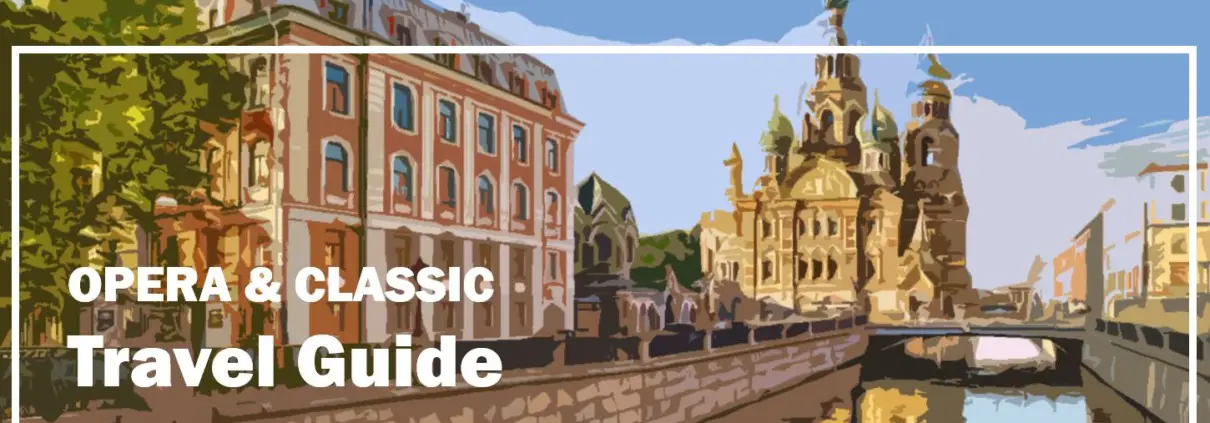


The Russian Cultural Heritage is enormous. So rich, so impressed.
Russia is a unique gem of the World.